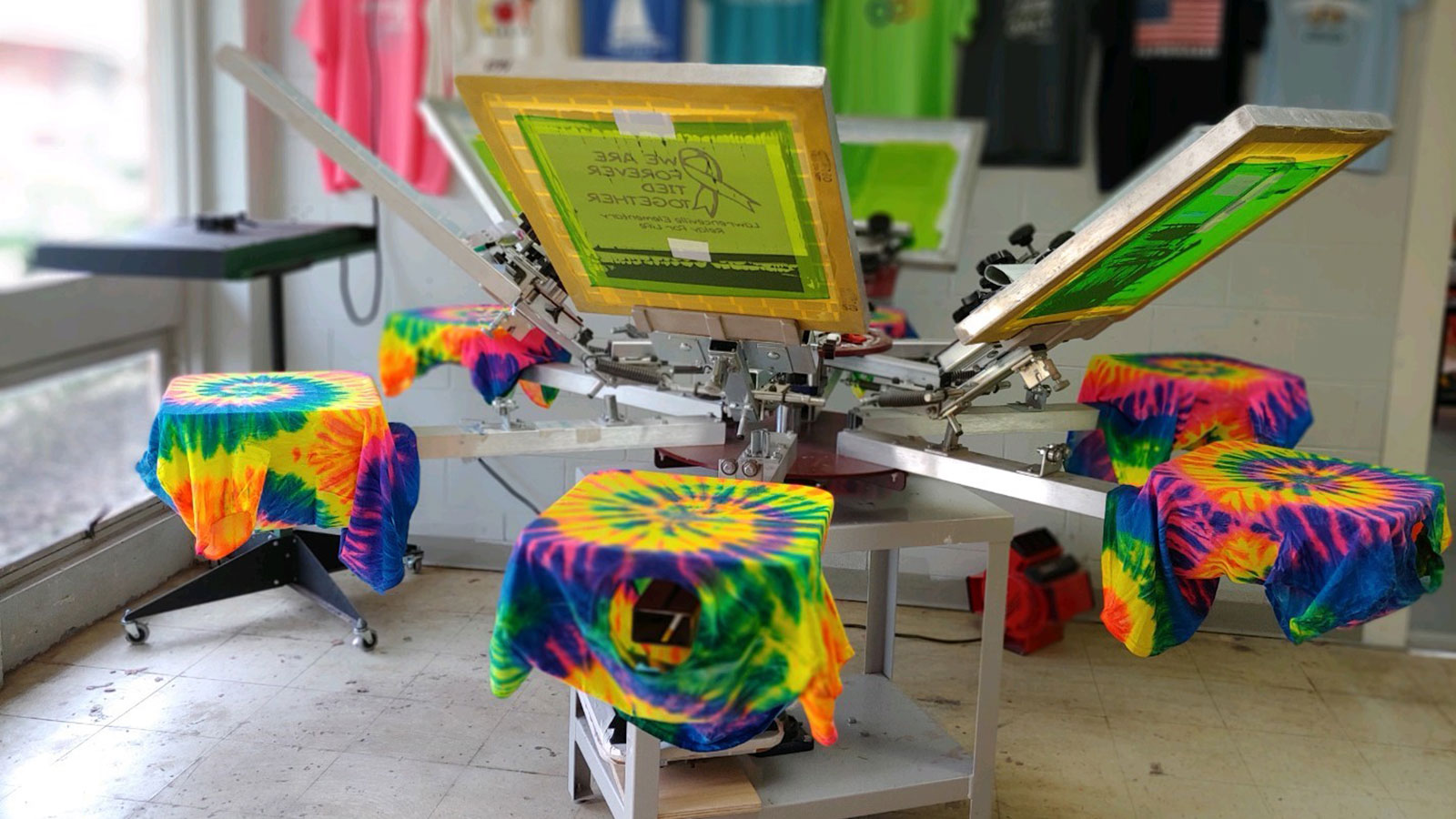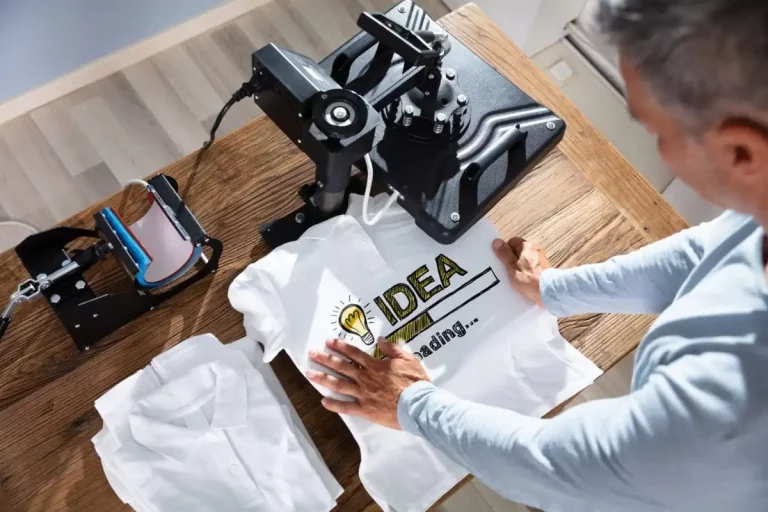Vintage Style Silk Screen Printing for Retro Fashion
Vintage Style Silk Screen Printing for Retro Fashion
Blog Article
Display Printing Uncovered: Whatever You Need to Understand About T-Shirt and Garment Printing Methods
Screen printing is an interesting approach that combines art with technique, providing endless opportunities for creative thinking. All set to explore the important elements that make screen publishing an art form?
The Basics of Display Printing: Exactly How It Works
When you plunge right into screen printing, you'll find it's both a science and an art. At its core, display printing includes creating a pattern, or screen, that permits ink to pass with just in particular locations.
Placement the screen over the material, after that utilize a squeegee to press ink with the display onto the garment. Each action is necessary, and grasping them will raise your display printing abilities, transforming basic garments right into distinct, meaningful items.
Kinds Of Screen Printing Methods
Once you understand the fundamentals of screen printing, it's time to check out the numerous methods that can raise your designs. One preferred approach is traditional display printing, where ink is pressed through a stenciled display.
An additional choice is plastisol printing, known for its longevity and dazzling shades, making it a preferred for numerous brands. Experiment with halftone printing to produce gradient effects and detailed layouts.
Vital Devices for Display Printing
To accomplish sensational cause screen printing, having the right equipment is fundamental. You'll require a tough screen printing framework, which holds the mesh that moves your design onto the garment. Next off, spend in top notch squeegees; these are necessary for using ink evenly across the display. You'll also need a good direct exposure system to create your displays, as well as a washout cubicle for cleaning them after use. A trustworthy warmth resource, like a conveyor dryer or warmth press, is critical for healing your prints to guarantee long life. Do not forget a correct work area, outfitted with tables and storage for your materials. Lastly, protective gear, such as gloves and masks, will maintain you secure from chemicals and inks. With the right devices, you'll be well on your means to generating professional-quality prints.
Choosing the Right Inks and Materials
When choosing inks and materials for screen printing, you need to take into consideration the kind of ink that works finest for your task. Think of material compatibility to ensure your styles look last and terrific lengthy. Discover environmentally friendly ink alternatives to make your printing procedure a lot more sustainable.
Kinds Of Screen Inks
Choosing the appropriate screen ink is vital for achieving lively, resilient prints that satisfy your job's needs. There are a number of kinds of display inks to take a look at. Specialty inks, such as glow-in-the-dark or metal, can include unique impacts to your designs.
Textile Compatibility Considerations
Understanding material compatibility is essential for attaining top quality screen prints, particularly since different materials react distinctly to different inks. Constantly examine your inks on example fabric to guarantee they adhere properly and keep shade integrity. Additionally, keep in mind that textile weight and appearance can impact the last outcome, so choosing the right ink and product combo is important for your task's success.
Eco-Friendly Ink Options
Eco-friendly inks are becoming a popular choice for display printers that want to decrease their ecological effect while keeping top quality. When selecting inks, think about water-based inks, which are much less damaging and less complicated to tidy up contrasted to traditional solvents. These inks bond well with materials, supplying lively results without toxic chemicals. You could additionally discover eco-solvent inks that utilize fewer unpredictable organic compounds (VOCs), making them a safer alternative for both your wellness and the world.
Furthermore, try to find inks made from renewable energies, such as soy or vegetable-based alternatives. By choosing the appropriate inks and products, you'll not just develop spectacular styles however also add to an extra lasting printing process. Make the switch, and your prints will mirror your commitment to the environment!
Preparing Your Layout for Screen Printing

File Layout Demands
To assure your style looks sharp and lively on material, you'll require to pay close attention to file layout demands for screen printing. Begin with vector files like AI or EPS, as they can be scaled without losing high quality. If you make use of raster photos, decide for high-resolution documents, such as TIFF or PNG, preferably at 300 DPI. Prevent using JPEGs, as they can shed clarity when resized. Make sure your layout has a clear background to avoid undesirable white sides on your prints. Keep color settings in mind; CMYK is conventional for display printing, so transform your RGB creates appropriately - screen printing kit. By complying with these guidelines, you'll establish your artwork up for a successful print.
Color Splitting Up Strategies
Shade splitting up is an essential action in preparing your layout for screen printing, and understanding it can substantially enhance your print top quality. You'll need to damage your design right into specific colors, as each shade calls for a separate screen during printing. Start by recognizing all the shades in your design and develop layers each. You can utilize software application like Adobe Photoshop or Illustrator to separate and different shades properly. Be certain to conserve each layer as a different file, usually in a layout like TIFF or PSD. This accuracy not only assures precise shade representation yet also simplifies the printing process. By focusing on color separation, you'll attain expert and lively lead to your screen-printed garments.
Resolution and Size
Accomplishing the most effective lead to screen printing begins with assuring your design has the best resolution and size. Preferably, your art work must go to the very least 300 DPI (dots per inch) for sharp, clear prints. If you use lower resolution, your last item might look pixelated and amateur.
When it concerns size, consider the measurements of your print area. Style your artwork to match the last print dimension, ideally creating it in the my review here actual measurements you'll be printing. This method, you'll prevent any kind of unanticipated scaling concerns.
Always check your design in both vector and raster layouts. Vector graphics can be scaled without losing quality, making them perfect for display printing. Preparing appropriately will ensure your layout looks outstanding on every garment!
Step-by-Step Screen Printing Process
Screen printing is a vibrant process that permits you to develop vivid layouts on various surfaces. To get started, you'll require a display, emulsion, and your picked ink.
After cleaning out the unexposed emulsion, your display is prepared. Set it up on your printing surface and align your garment under it. Put ink onto the screen and utilize a squeegee to push the ink through the stencil onto the textile. Lift the display carefully and allow the print completely dry. Finally, treat the ink using heat to assure durability. That's it! You have actually successfully display published your style.
Tips for Effective Screen Printing Projects
While you're diving right into your screen printing jobs, keep in mind that prep work is essential to success. Beginning by collecting all your materials-- inks, displays, garments, and squeegees. A tidy workspace helps avoid unwanted errors, so tidy up before you begin.
Next, confirm your artwork is high-resolution and effectively sized for your garment. Test your screen for proper direct exposure and tidy it thoroughly to stay clear of smudges. When blending your inks, follow the manufacturer's guidelines to achieve the best uniformity.
Throughout printing, use even pressure with your squeegee for constant results. Do not rush; take your time to validate each print fulfills your standards. After printing, allow your garments dry completely before handling or packaging them.
Last but not least, always maintain a sample of your help future recommendation. By doing this, you can evaluate your progress and boost your techniques over time. Pleased printing!

Often Asked Concerns
The length of time Does It Take to Establish a Display Printing Job?
Establishing a display printing work typically takes about 30 mins to an hour. You'll prepare the screens, mix inks, and readjust the press. The moment varies based on complexity and experience, so stay arranged!
Can I Print on Various Fabric Keys In Utilizing the Very Same Method?
Yes, you can print on different textile kinds utilizing the very same technique, yet you'll require to change your inks and setups. Some materials absorb ink differently, so trying out guarantees the finest outcomes for every material.
What Are Usual Blunders to Prevent in Screen Printing?
When screen printing, avoid usual blunders like making use of the wrong ink, disregarding appropriate direct exposure times, or skipping pre-press checks. Constantly test your arrangement and preserve clean screens to ensure quality results each time.
Just How Can I Correctly Tidy and Preserve My Display Printing Devices?
To properly tidy and preserve your display printing devices, you ought to routinely wash displays with appropriate solvents, inspect squeegees for wear, and guarantee all devices are kept completely dry and dust-free. Uniformity avoids pricey repair work and boosts efficiency.
Is Display Printing Eco-friendly Compared to Various Other Methods?
Display printing can be a lot more eco-friendly than other approaches, especially if you use eco-conscious materials and water-based inks. By choosing lasting supplies and practices, you minimize waste and minimize your impact on the earth.
Display Printing Uncovered: Whatever You Required to Know Regarding Tee and Garment Printing Methods
At its core, screen printing involves developing a stencil, or display, that allows ink to pass with only in particular areas. Position the screen over the textile, then make use of a squeegee to Discover More Here push ink through the display onto the garment. One popular method is typical display printing, where ink is pressed with a stenciled display.When picking inks and materials for display printing, you require to take right into account the kind of ink that functions best for your project.
Report this page